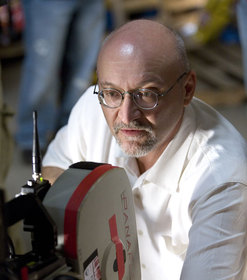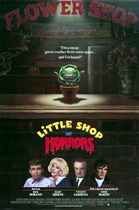Our editor-in-chief Nate Yapp is proud to have contributed to the new book Hidden Horror: A Celebration of 101 Underrated and Overlooked Fright Flicks, edited by Aaron Christensen. Another contributors include Anthony Timpone, B.J. Colangelo, Dave Alexander, Classic-Horror.com's own Robert C. Ring and John W. Bowen. Pick up a copy today from Amazon.com!
Frank Darabont (The Mist) interview
In November of 2007, Dimension Films released The Mist, a film adaptation of Stephen King’s novella of the same title written and directed by Academy Award nominated director, Frank Darabont. With a limited budget, a darker ending, and a talented cast, The Mist is a moody, thoughtful modern horror film without an annoying Pollyanna ending.
The film stars Thomas Jane as David Drayton, a commercial artist living in a small town with his wife and son, Billy. After a violent thunderstorm, Thomas and Billy, head to the local supermarket to pick up supplies when an unnatural mist begins to roll into town, preceeded by a frightened neighbor telling stories of dangerous creatures in the Mist. What follows is a story of terror and paranoia, as a group of people, trapped in the supermarket, attempt to survive both the otherworldly creatures lurking in the Mist and the threat of panicked people lurking in their midst.
Now, nearly one year later, Dimension Films is releasing a Blu-Ray Special Edition of the film. In addition to the superior display quality afforded by the Blu-Ray format, The Mist Special Edition will contain a number of special features not available on the original, single disc release. Most notable of these extras is the full-length film presented in Frank Darabont’s preferred black-and-white format, complete with introduction explaining his choice to offer this alternate version of the film.
In anticipation of the Blu-ray release, Classic-Horror.com had the opportunity to interview Frank Darabont at Comic-Con 2008, and ask him about his thoughts on the black and white format, on the effects, and on his role as a new horror director.
Classic-Horror.com: The first thing we wanted to talk to you about was your decision to offer The Mist in black-and-white, and to endorse it as the best version of the film.
Frank Darabont: I wouldn’t call it the best version. I think my preferred version, my favorite version, but I wouldn’t call it the best version. I think that’s up to the people who are fans of the movie. They can decide for them which version they prefer. I think each version, color or black-and-white, are equally valid. Each has its strengths. It’s just a matter of which do you think is cooler - something that looks like it was made in the mid-to-late 70s or something that feels like it was made in the late 50s, early 60s. You know, what is the feel, what is the taste in your mouth that you’d like from that experience, So I just felt that both were pretty valid ways to go for that movie, which is why I wanted to offer both.
And it’s lovely to have the power, with the digital process of post, to do that. And with DVDs we can do that. It’s not a big argument with the studio, should we release the movie in black-and-white or should we do it in color, because that’s always a big conversation. The marketplace doesn’t necessarily support black-and-white movies anyway, so it’s a hard argument to put forth.
C-H: Well, what do you think the benefits are of a movie in black-and-white?
Darabont: I think it’s a tonal thing. It puts my head right back into that low-budget, Night of the Living Dead-era of filmmaking. Or just prior to that with some of the crazy, big-bug science fiction movies. Which, to my mind, black-and-white kind of enhances in a way. Puts me back into the headspace of that nine, ten, eleven year old kid who stayed up to all hours, this was pre-video mind you, to catch some old movie on the tube ‘cause it was a horror picture. ‘Cause that’s what turned me on; that’s what made me happy. And, funny enough, that’s what we wanted to create with the effects work, which I contend is pretty substantially fantastic effects work considering we had a 4 million dollar effects budget…
C-H: That’s it?
Darabont: That’s it.
C-H: Wow. That’s pretty impressive.
Darabont: Yeah, whoever bitches about my tentacles, (leaning into recorder) f**k you. Do better on a four million dollar effects budget. CafeFX did fantastic, flawless, committed work. Well, what’s interesting about it is I always wanted to have that sense of the old Ray Harryhausen creatures. I think, partially, Stephen King himself was drawing from that inspiration, right. And I think in black-and-white the effects take on a whole different feel. I think that sense of wanting it to be a little bit Harryhausen comes out more. We’re used to seeing that style of creature in an old black-and-white venue. A lot of those great Harryhausen pictures were black-and-white. It’s 20 Million Miles to Earth or, I’m blanking on the name right now, what is it? It Came From Beneath the Sea?
C-H: I think so. In order to get the print in black-and-white after you film it, is it just a matter of changing the color scheme?
Darabont: No. You see, it’s a bit of a misconception that all you do is print a copy with the color turned off. That’s not at all what you do. When you’re putting together any movie, every shot has to be what they called “timed”. Which actually has nothing to do with the length of the shot. It has to do with the exposure, the contrast, you know. There’s a lot of subtleties that actually go into timing it, and you have to do that shot by shot to get the look you want, to keep it consistent, etc, etc, So when we did the black-and-white version, we went back in and we redid that process, in the lab, in the edit bay, with my color timer, Keith Shaw, who is a great guy and has done all my DVDs back to Shawshank. Or at least the good versions of that. Because there was a really badly done quick dub they tossed on video and then laser disc, and I think the first DVD was that transfer. We finally got a good transfer on there and Keith Shaw did it. Anyway, Keith went back in and retimed the movie to be a black-and-white film. Cause you need to compensate for the lack of color.
Anyway. The Coen Brothers did it with The Man Who Wasn’t There and they pointed the way, to me, for the idea of having a black-and-white version of the movie. And why not? They shot that film in color; they used color negative stock. When they put it through the post process, they decided, “You know, we like it better as a black-and-white movie,” so they timed it and then output it. And I thought, “That’s awesome!” I mean, why not? We have so many alternate possibilities. People do alternate cuts all the time. They restore scenes - often scenes they didn’t need to restore, and they do it anyway. Or the directors cut of this, that and the other. I don’t know, what are there, 519 versions of Blade Runner now? Why not do a black-and-white version [of The Mist]? Just for the fun of it, just for the people who would really dig that. You know, lock themselves in on a Saturday night, turn the lights down and watch it like it’s an old black-and-white movie ‘cause they might dig doing it that way. Why not? It’s fun,
C-H: A lot of your films have a horror influence, and this one is definitely in that category. What do you like about directing horror films?
Darabont: Well, this was really my first. I mean, The Green Mile definitely flirted with some fantastic elements, flirted with them barely. This really was my first horror movie. I’ve been wanting to do one since I was a kid. I’ve wanted to make this kind of down and dirty, low budget – which is what it was – kind of horror movie. Hopefully something with a little bit of muscle and some thought behind it. And man, what didn’t I love about making this movie.
I loved getting out of my comfort zone as a director, because you develop a certain skill set, and then you learn to depend on that skill set, and if you’re not careful, you get stale doing that skill set. And I had this very carefully crafted approach. That’s my influence from having grown up watching Stanley Kubrick movies and other elegant filmmakers, But, in my head, there was also a guy who grew up watching George Romero pictures and David Cronenberg movies and these rough, down-and-dirty, kill-the-vampire kind of movies. And it was great to get out of my comfort zone, to throw all my careful craft aside, and embrace all the ragged edges of shooting that fast, that intensely.
The entire movie was shot in 6 weeks, which is less than half the schedule I’ve ever had before. And in a lot of these scenes we had a dozen leads and 80-100 extras. But we’re still cranking out pages like crazy bastards and it’s not about elegance. It’s about improvising, and camerawork, etc etc. I think that lent itself to the material, and it was liberating. It was a blast and I had so much fun, You know, there is always time to be elegant again, but I have to say, I loved expanding the skill set of what I know and what I do into a more distinctive sort of terrain, And that was really kind of great.
C-H: Alright, we’ve got one more question. What was your favorite scene in the movie?
Darabont: Oh, that’s actually, well, I’ll give you two, ok. My favorite scenes in movies are always the ones where the actors just get to talk, to relate to one another in a moment and everyone was doing such great work. It was a scene where they stop and talk in the back room, there’s Thomas Jane and Toby Jones and Jeffery DeMunn and Robert Treveiler. They just brought in the body [of the woman who committed suicide] in, they talk about how much trouble is brewing. It’s about a four-minute sequence and all the actors are doing such good work there. And I love the camera work that my operators found in the moment. I love that scene.
And the other scene I love, my other favorite scene, really is when Nathan Gamble, who plays Billy, is begging his dad not to go the pharmacy. And he’s in tears and he’s on the verge of panicking, and just the connection between Tom and Nathan in the scene is, I find, very powerful. And I think Nathan was doing amazing work. He’s a 9 year old kid, and I don’t remember how many takes I did, 5 or 6 takes or whatever. Each take I asked him to crank it up some more. And he did. He really went to this emotional place where he’s sobbing. That’s not make-up; that’s not him pretending. That’s that kid actually doing what he’s doing. And I’m blown away by that. That kind of talent at nine, are you f**king kidding me? So, those two scenes, probably because they’re the most immediate emotional connections in the movie - those are my favorites.
Classic-Horror.com would like to thank Frank Darabont for taking the time to talk to us about The Mist.








